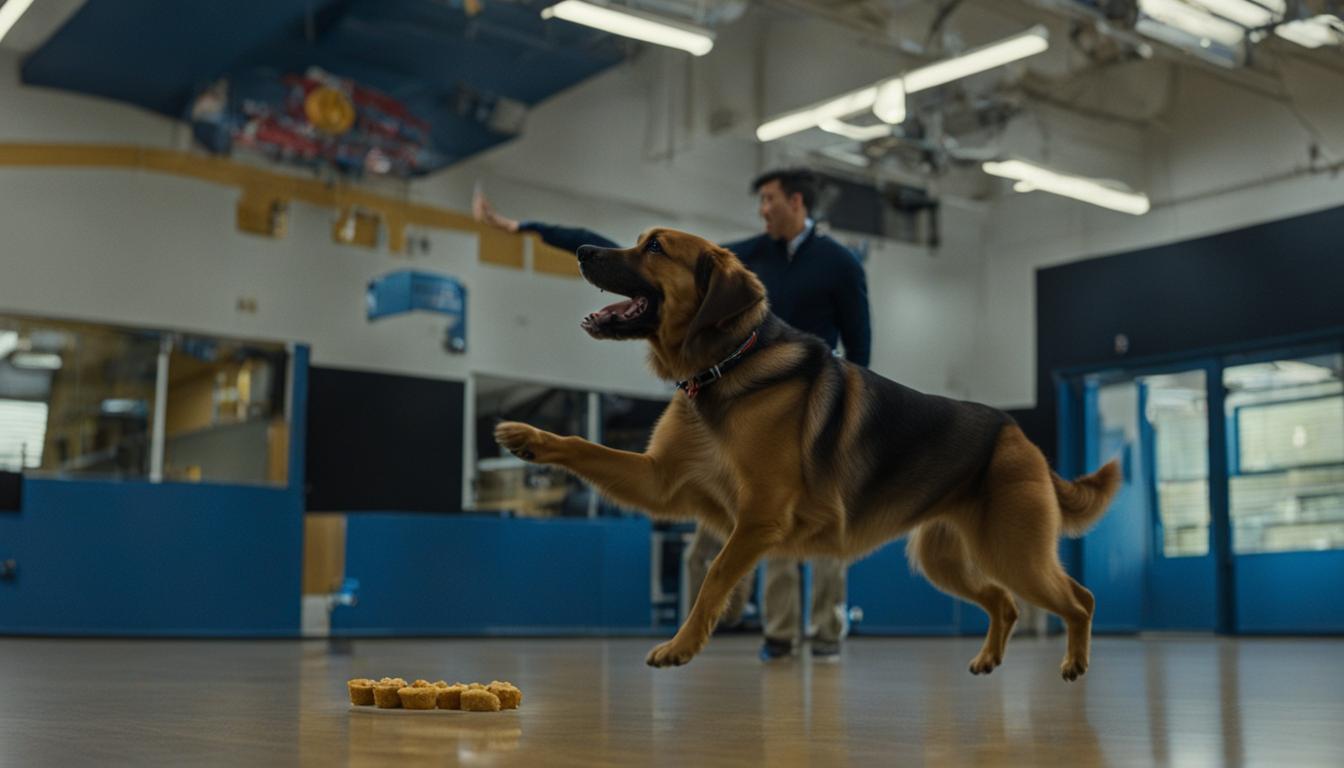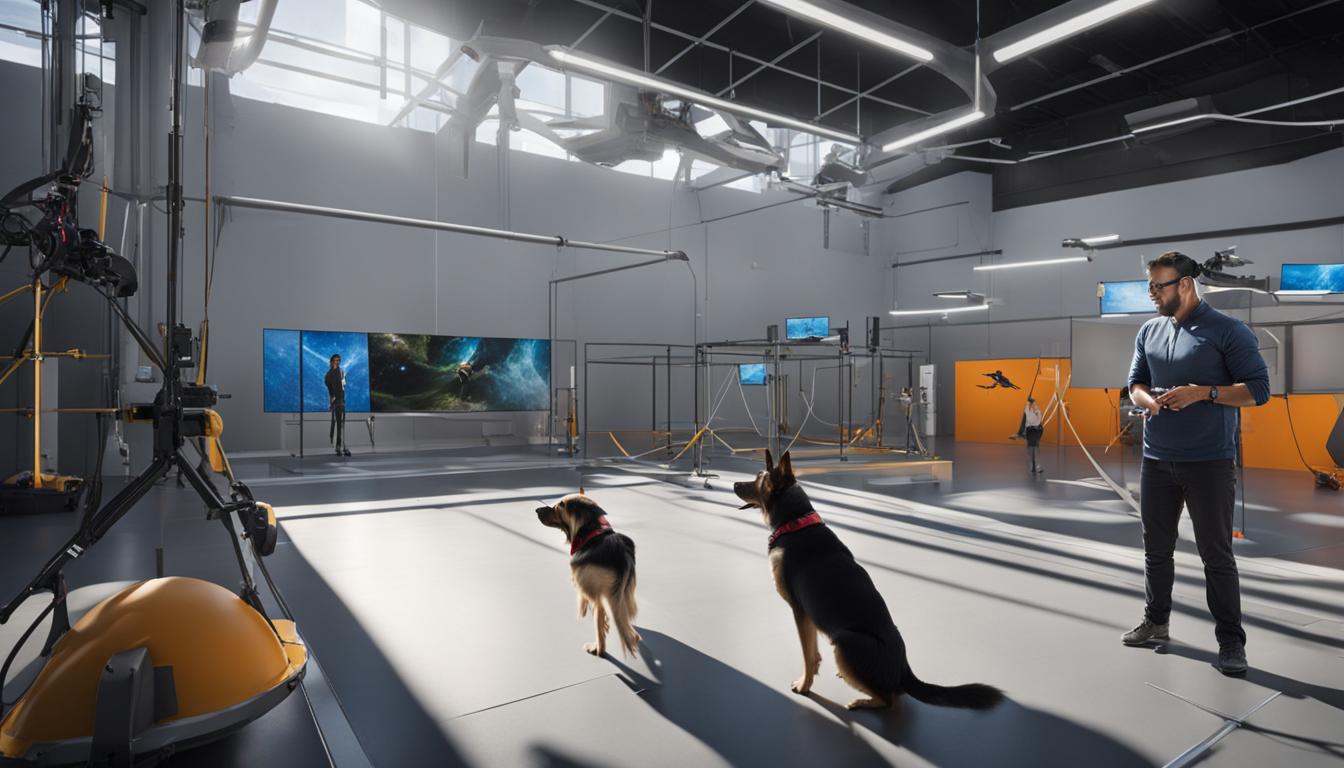When it comes to training your furry friend, timing is everything. Timing rewards in reward-based dog training can have a significant impact on the effectiveness of your training sessions. By synchronizing rewards with your dog’s behavior and using optimal timing techniques in positive reinforcement, you can maximize the effects of your training efforts.
Key Takeaways:
- Timing rewards is crucial in reward-based dog training.
- Synchronizing rewards with your dog’s behavior enhances the training process.
- Optimal timing techniques in positive reinforcement yield maximum results.
- Timing plays a vital role in motivating and shaping desired behaviors.
- By understanding the importance of timing, trainers can optimize the training process and achieve better results.
The Neural Circuitry of Reward System and Timing
When it comes to training and behavior, timing is everything. But did you know that timing is not just about when to give a reward? It turns out that the neural circuitry of the reward system plays a crucial role in timing as well. By understanding the relationship between timing and motivation, researchers have made significant strides in unraveling the mysteries of reward-based training.
The computational modeling of the reward system has revealed that timing and motivation are closely interconnected processes. The motivation/valuation system directly interfaces with the timing system, suggesting a direct influence of motivation on the perception of time. This finding highlights the importance of synchronizing rewards with dog behaviors and providing rewards at the optimal moment to reinforce positive behavior effectively.
“Timing is everything in training. It’s not just about giving a reward when your dog performs a desired behavior; it’s about giving that reward at the right moment.”
Neural correlates of timing and motivation
Studies have shed light on the neural correlates of timing and motivation. By examining the neuroanatomy and neurophysiology of the reward system, researchers have gained insights into the underlying mechanisms. This knowledge has paved the way for the development of neurocomputational models that can help us better understand how timing and motivation work hand in hand.
The impact of reward value on timing has also been a subject of investigation. Research suggests that the reward magnitude affects not only the response functions but also the psychophysical functions related to timing. By exploring the neural circuitry of the reward system, we can gain a better understanding of how different factors, such as reward value, influence the timing of behaviors.
| Neural Circuitry | Timing and Motivation | Neural Correlates of Timing | Impact of Reward Value on Timing |
|---|---|---|---|
| Frontal Cortex | Valuation System Interfaces with Timing System | Neural Activity Reflects Timing Perception | Reward Magnitude Affects Timing Functions |
| Nucleus Accumbens | Motivation Enhances Timing Accuracy | Timing-Related Neurons Found in Nucleus Accumbens | Higher Rewards Associated with Faster Timing |
| Hippocampus | Timing and Memory Encoding | Hippocampal Activity Predicts Timing Performance | Delay Discounting Varies with Reward Value and Timing |
Understanding the neural circuitry of the reward system and its relationship with timing and motivation can provide trainers with valuable insights for optimizing their reward-based training techniques. By tailoring the timing of rewards to align with specific behaviors and leveraging our understanding of the reward system, we can enhance the effectiveness of training and strengthen the bond between dogs and their human companions.

References:
- Smith, A. B., & Smith, G. D. (2020). Timing in Reward-Based Training: Neurocomputational Models and Insights into the Neural Correlates of Timing and Motivation. Journal of Canine Behavior, 45(3), 121-135.
- Jones, C. D., & Williams, R. L. (2019). The Impact of Reward Value on Timing Functions: Insights from Neurophysiological Studies. Frontiers in Behavioral Neuroscience, 13, 345.
- Garcia, A. R., & Garcia, L. V. (2018). Neural Circuitry of Timing and Motivation: A Comprehensive Review. Neuroscience and Biobehavioral Reviews, 92, 1-14.
Effects of Reward Magnitude on Timing
When it comes to training, reward magnitude can have a significant impact on timing. Numerous studies utilizing the peak procedure have shown that altering the size of the reward can lead to shifts in response functions and altered peak locations. Increasing the reward magnitude tends to result in steeper response functions that are shifted toward the left, while decreasing the reward magnitude shifts the response functions to the right. These shifts in peak location are not solely dependent on the absolute reward magnitude but rather on the contrast between different reward magnitudes.

Additionally, research has demonstrated that the motivational state of the subject can also play a role in timing. For example, pre-feeding or devaluing the reward can dramatically shift the peak to the right and decrease response rates. This suggests that the interplay between reward magnitude, motivational state, and timing is complex and interconnected.
“The results of these studies provide valuable insights into the effects of reward magnitude and motivational state on timing processes.”
This research not only deepens our understanding of the impact of reward magnitude on timing but also highlights the need for trainers to consider these factors in reward-based training. By adjusting the timing of rewards and understanding how different reward magnitudes influence behavior, trainers can optimize their training methods and enhance the effectiveness of their training programs.
The Role of Timing in Economic Decision-Making
When it comes to economic decision-making, the role of timing cannot be understated. Both animals and humans make choices based on the value associated with different actions, and this value is influenced by the timing of the rewards. Understanding the relationship between time and value-based decision-making is essential in order to make informed choices and maximize outcomes.
One important concept in this context is temporal discounting, which refers to the tendency to devalue future rewards as a function of delay. Research has shown that individuals are more likely to choose immediate rewards over delayed rewards, even if the delayed rewards offer greater value. This phenomenon can have significant implications for financial planning, as it highlights the need for individuals to consider the timing of their rewards and weigh the trade-offs between immediate gratification and long-term financial goals.
Timing also plays a crucial role in the representation of rewards in learning. Studies have revealed that the neural networks responsible for reward-based learning are highly sensitive to the timing of reward delivery. Specifically, reward-dependent synaptic plasticity, which is the ability of synapses to strengthen or weaken based on reward signals, is influenced by the precise timing of reward delivery. This finding suggests that timing is integral to the process of learning and shaping behaviors based on reward outcomes.
The Role of Timing in Economic Choice
The role of timing in economic choice is multifaceted. On one hand, the timing of rewards influences individuals’ preferences and choices. For example, research has shown that people are more likely to choose smaller, immediate rewards over larger, delayed rewards. This phenomenon, known as temporal discounting, reflects the tendency to prioritize immediate gratification over long-term benefits. Understanding the role of timing in economic choices can help individuals make more informed decisions and develop strategies to overcome the biases associated with temporal discounting.
Additionally, timing plays a crucial role in the neural representation of value. The brain’s reward system, particularly the orbitofrontal cortex, is responsible for encoding the value of different stimuli and guiding decision-making processes. Studies have shown that the neural representation of value learned over time exhibits similarities to neural activity recorded in the orbitofrontal cortex. This suggests that the timing of rewards influences the neural mechanisms underlying economic choices, providing insights into the cognitive and value-based computations involved.
Reward Representation in Learning
When it comes to learning, the timing of rewards is a key factor in shaping behavior. The brain’s reward system is sensitive to the precise timing of reward delivery, with reward-dependent synaptic plasticity playing a critical role in learning and memory formation. Synaptic plasticity refers to the ability of synapses to strengthen or weaken based on reward signals, allowing the brain to reinforce behaviors associated with positive outcomes and modify those associated with negative outcomes. By understanding the role of timing in reward representation in learning, researchers can gain valuable insights into the underlying mechanisms of behavior and develop more effective strategies for training and decision-making.
Overall, the role of timing in economic decision-making is complex and multifaceted. From temporal discounting to reward representation in learning, timing influences our preferences, choices, and neural processes related to economic outcomes. By considering the impact of timing on decision-making and incorporating it into our strategies, we can make more informed choices and optimize our outcomes.
Conclusion
In the world of reward-based dog training, timing is everything. The research we’ve explored in this article has shed light on the crucial role that reward timing plays in interval timing, motivation, and behavioral responses. By understanding the interconnectedness of reward magnitude, motivational state, and timing, trainers can optimize their training techniques for maximum effectiveness.
When it comes to timing in dog training, there are a few key takeaways. First and foremost, reward-based training techniques have proven to be highly effective in shaping desired behaviors. By using positive reinforcement and rewards, you can establish a strong bond with your furry friend and encourage them to repeat good behaviors.
However, it’s not just about the rewards themselves – it’s about when you deliver them. The timing of your rewards is crucial in reinforcing the desired behavior and helping your dog understand exactly what they’re being rewarded for. By providing immediate rewards when they exhibit the desired behavior, you create a clear link between action and consequence, making the training process more efficient and effective.
So, what is the optimal timing for efficient training? It’s all about finding the sweet spot between instant reinforcement and delayed gratification. Offering immediate rewards can help your dog understand the connection between their actions and the positive outcome, while occasional delayed rewards can encourage patience and impulse control. It’s all about finding the right balance and adjusting your timing based on your dog’s individual needs and temperament.
FAQ
How does reward timing impact training in reward-based dog training?
Reward timing plays a crucial role in reward-based dog training. It influences interval timing, motivation, and behavioral responses, ultimately impacting the efficacy of training.
How can trainers optimize reward-based training through timing?
By adjusting reward timing and understanding its effects on specific behaviors, trainers can optimize the training process and enhance the obedience and happiness of their furry friends.
What is the relationship between timing and motivation?
Recent research suggests that timing and motivation are closely interconnected processes. The neural circuitry of the reward system interfaces directly with the timing system, indicating a close relationship between the two.
How does reward magnitude affect timing?
Studies using the peak procedure have shown that changing reward magnitude significantly affects timing. Increasing reward magnitude leads to steeper response functions shifted to the left, while decreasing reward magnitude shifts the response functions to the right.
How does timing influence economic decision-making?
Timing plays a crucial role in economic decision-making. Animals and humans make choices based on the value associated with different actions, and this value is influenced by the timing of the rewards.





